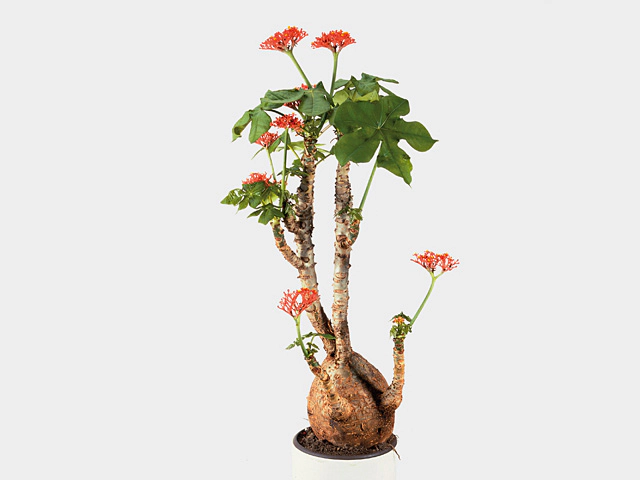Jatropha podagrica

| Leaf base | Cordate (heart-shaped) |
| Leaf type | Foliage leaf |
| Flower color | Red-light red-033A |
| Plant height | 1,8 - 2 m |
| Inflorescence | Cyathium (spurges) |
| Structure (tissues) | Woody |
| Plant, growth type | Erect |
Jatropha podagrica, also known as Gout Plant or Buddha Belly Plant, is a fascinating and visually striking plant. It belongs to the Euphorbiaceae family and is native to Central America. This tropical plant is known for its unique features and attractive appearance.
One notable characteristic of Jatropha podagrica is its leaf base, which is cordate or heart-shaped. The leaves of this plant are foliage leaves, meaning they are primarily grown for their aesthetic appeal rather than for their ability to perform photosynthesis. The leaves exhibit a deep green color, providing a beautiful contrast against the vibrant flowers.
Speaking of flowers, Jatropha podagrica boasts stunning red to light red blossoms. The specific shade of red is known as red-light red-033A, which adds a touch of elegance to the overall appearance of the plant. These blossoms are arranged in inflorescences called cyathium. The cyathium is a characteristic feature of spurge plants, to which Jatropha podagrica belongs.
The plant can reach a height of 1.8 to 2 meters, making it an impressive addition to any garden or landscape. Its growth type is erect, meaning it grows upright, giving it a commanding presence. The plant's woody structure adds to its sturdiness and longevity, making Jatropha podagrica a great choice for those looking for a long-lasting ornamental plant.
Aside from its aesthetic appeal, Jatropha podagrica also has some practical uses. The plant is known for its medicinal properties and has been traditionally used in indigenous cultures for various purposes. Its sap has been employed to treat skin conditions, including warts and fungal infections. However, it is important to note that consulting a healthcare professional is essential before attempting any form of self-medication.
Caring for Jatropha podagrica involves providing it with well-draining soil, adequate sunlight, and occasional watering. As a tropical plant, it thrives in warm climates and is generally resilient when it comes to pests and diseases. However, like any plant, it is essential to keep an eye out for any signs of distress and address them promptly to maintain the plant's health and longevity.
In conclusion, Jatropha podagrica is a magnificent plant with its heart-shaped leaves, vibrant red flowers, and erect growth habit. Its woody structure and unique inflorescence add to its overall charm. Whether you are looking for an eye-catching addition to your garden or a plant with potential medicinal benefits, Jatropha podagrica is definitely worth considering. With proper care, this tropical beauty can bring joy and beauty to any setting.
Market availability index by month:
| Jan. | Feb. | Mar. | Apr. | May | Jun. | Jul. | Aug. | Sep. | Oct. | Nov. | Dec. |
|---|---|---|---|---|---|---|---|---|---|---|---|
| 3 | 4 | 3 | 2 | 1 | 1 | 1 | 1 | 1 | 2 | 2 | 1 |